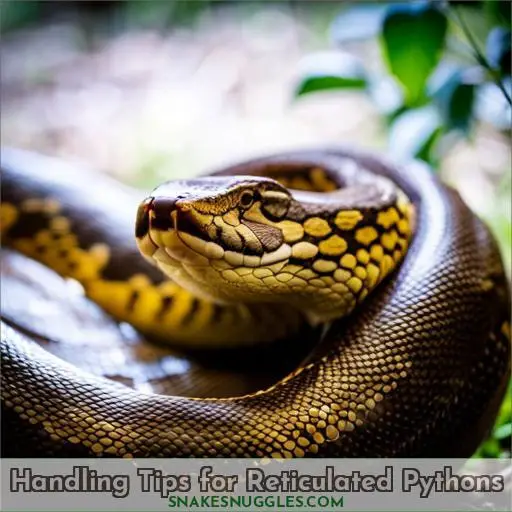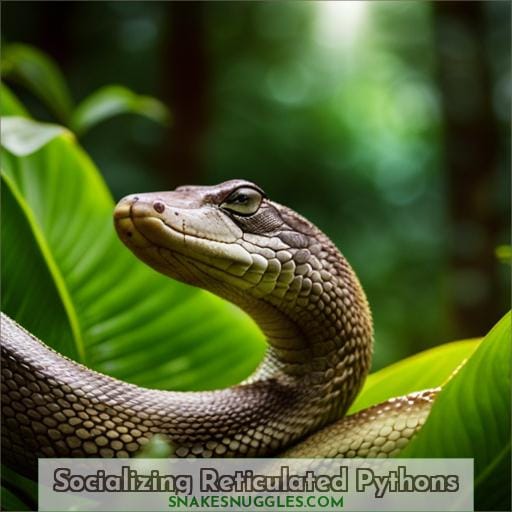This site is supported by our readers. We may earn a commission, at no cost to you, if you purchase through links.
 Curious about the temperament of a reticulated python? Look no further. In this article, you will gain a comprehensive understanding of these powerful snakes and their behavior. From factors influencing their temperament to tips for handling them safely, we’ve got you covered.
Curious about the temperament of a reticulated python? Look no further. In this article, you will gain a comprehensive understanding of these powerful snakes and their behavior. From factors influencing their temperament to tips for handling them safely, we’ve got you covered.
Discover how to build trust with your reticulated python and develop a bond that allows you to confidently interact with these magnificent creatures.
Table Of Contents
- Key Takeaways
- Reticulated Python Temperament Overview
- Factors Influencing Reticulated Python Temperament
- Understanding Reticulated Python Behavior
- Taming a Reticulated Python
- Handling Tips for Reticulated Pythons
- Enclosure Setup for Reticulated Pythons
- Socializing Reticulated Pythons
- Dealing With Defensive Reticulated Pythons
- Handling Large Reticulated Pythons
- Developing a Bond With Your Reticulated Python
- Frequently Asked Questions (FAQs)
- Conclusion
Key Takeaways
- Captive vs. wild-caught reticulated pythons have different temperaments and behaviors.
- Age and socialization play a significant role in shaping the temperament of reticulated pythons.
- Reticulated pythons have defensive postures and fear responses that should be understood for safe handling.
- Learning, adaptability, and cognitive flexibility are important aspects of reticulated python behavior and temperament.
Reticulated Python Temperament Overview
In this section, we’ll provide an overview of the Reticulated Python’s temperament.
Understanding their behavior and disposition is crucial for successful ownership.
The temperament of Reticulated Pythons can vary greatly depending on factors such as captive-bred versus wild-caught, age and socialization, and individual personality traits.
Captive-bred specimens tend to be more tractable due to greater trust in keepers from an early age.
Socialization strategies play a significant role in developing a positive relationship with these snakes, including consistent and positive interaction to build trust and rapport over time.
Behavioral influences like defensive instincts should be understood when handling challenges arise; patience, respect,and proper techniques are essential for safe interactions with these powerful reptiles
Factors Influencing Reticulated Python Temperament
When it comes to understanding the temperament of a reticulated python, several factors come into play.
Firstly, whether the snake is captive-bred or wild-caught can have a significant impact on its behavior and disposition towards humans.
Additionally, age and socialization also influence their temperament as younger snakes may be more defensive while older individuals can display varying levels of trust towards handlers.
Lastly, like any animal, each reticulated python has its own unique personality which further contributes to their overall temperament.
Captive-bred Vs. Wild-caught
When considering the factors that influence a reticulated python’s temperament, it’s important to compare captive-bred snakes with their wild-caught counterparts.
-
Captive-bred advantages:
- Raised in controlled environments
- Handled from a young age
- More likely to have predictable and docile behaviors
-
Behavioral differences:
- Wild-caught snakes may be more defensive or aggressive due to stress and lack of socialization.
-
Environmental impact:
- Captive breeding reduces the need for capturing wild pythons, which helps conserve natural populations.
-
Ethical considerations and conservation efforts:
- Supporting captive breeding promotes responsible pet ownership while protecting wild populations through sustainable practices available at online reptile shops
Age and Socialization
As an owner, you can influence the temperament of your reticulated python through age and socialization.
Juvenile behavior in retics may be defensive, but with consistent positive interactions and handling, they can become more tractable.
Adult interactions also play a role in shaping their disposition.
Individual Personality
One factor that plays a significant role in shaping the temperament of reticulated pythons is their individual personality.
Each snake has unique behaviors, personal quirks, and behavioral cues that contribute to their temperament nuances.
Understanding these individual traits can help in handling reticulated pythons effectively.
Understanding Reticulated Python Behavior
When it comes to understanding the behavior of reticulated pythons, there are several key points to consider.
Firstly, these snakes exhibit defensive behavior as a natural response when they feel threatened or cornered.
Secondly, their predatory instincts play a significant role in how they interact with their environment and potential prey.
Lastly, reticulated pythons are known for their learning ability and adaptability, which contributes to their survival skills in the wild.
By understanding these aspects of reticulated python behavior, you can better care for and handle them responsibly as captives.
Defensive Behavior
If you encounter a defensive reticulated python, it will display instinctual behaviors to protect itself.
- Defensive postures: A defensive python may coil its body tightly and raise its head in an S-shaped position, ready to strike if threatened.
- Fear responses: Reticulated pythons can exhibit fear responses such as hissing, lunging, or biting when they feel threatened or cornered.
- Handling stress: Stressful situations like improper handling techniques or excessive noise can trigger defensive behavior in reticulated pythons.
By understanding these defense mechanisms and employing trust-building techniques through consistent positive interactions and following safety precautions during handling, you can create a safer environment for both yourself and your reticulated python companion.
Predatory Instincts
How do reticulated pythons exhibit their predatory instincts?
Reticulated pythons display various instinctual responses during hunting dynamics. Their feeding patterns involve strategic prey interaction, such as ambushing and constricting their targets. Understanding these predatory behaviors is crucial for handling tips and ensuring successful captive care of reticulated pythons.
| Predatory Behavior | Instinctual Responses | Hunting Dynamics |
|---|---|---|
| Ambushing | Striking from hiding | Surprise attacks |
| Constricting | Coiling around prey | Restraining movement |
Learning and Adaptability
You can observe a reticulated python’s learning and adaptability through its behavior. These snakes exhibit cognitive flexibility, making behavioral adjustments based on their environment. They possess adaptive responses that allow them to learn patterns and demonstrate environmental awareness, showcasing their remarkable adaptability in handling different situations.
Taming a Reticulated Python
When it comes to taming a reticulated python, building trust and rapport is crucial.
Consistent and positive interaction with the snake helps them realize that you aren’t a threat.
Patience and respect are key in establishing a bond with your reticulated python, especially if it’s wild-caught or has had limited human contact.
Building Trust and Rapport
To build trust and rapport with your reticulated python,
- Regularly interact with the snake in a consistent and positive manner.
- Show patience and respect while handling it, using gloves or other protective measures as necessary.
- Provide ample space for the snake to move and create hiding spots within its environment.
Consistent and Positive Interaction
To establish trust and build a bond with your reticulated python, consistently interact with the snake in a positive manner.
Show patience and respect, using positive reinforcement to reward desired behaviors.
Create predictability by maintaining consistent handling sessions and providing proper heat, humidity, and water conditions for their comfort.
Patience and Respect
When taming a reticulated python, approach with patience and respect for the snake’s natural instincts.
- Respect boundaries and understand cues.
- Build rapport through consistent positive interaction.
- Establish trust by practicing patience and avoiding forceful handling techniques.
Handling Tips for Reticulated Pythons
When handling a reticulated python, it’s important to choose the right time and environment.
- Find a calm moment when the snake is in a relaxed state.
- Approach it with caution.
Use proper handling techniques such as:
- Supporting its body.
- Avoiding sudden movements.
- Being aware of its sensitive areas like the face and head.
Consider using gloves or other protective measures for added safety during interaction with these powerful snakes.
Choosing the Right Time and Environment
When handling reticulated pythons, choose the right time and environment for safe and comfortable experiences.
Consider their behavioral adaptation, seasonal considerations, and environmental adjustments.
Understand their temperament to ensure proper enclosure choices and time-sensitive handling techniques.
Proper Handling Techniques
When handling a reticulated python, ensure safe restraint by using proper techniques.
Provide gentle support for the snake’s body and be mindful of your interactions.
Use calming cues to build confidence and promote a positive experience for both you and the snake.
Using Gloves and Protective Measures
To ensure your safety while handling reticulated pythons, it’s important to use gloves and other protective measures.
Choose sturdy gloves that provide hand protection without compromising dexterity.
Proper technique and the right safety gear are crucial when dealing with their size potential.
Enclosure Setup for Reticulated Pythons
When setting up an enclosure for your reticulated python, it’s crucial to provide adequate space for the snake to move and stretch.
Consider the size of your snake and choose a cage that allows ample room for them to sprawl comfortably.
Additionally, creating hiding spots within the enclosure will help make your retic feel secure and reduce stress levels.
Lastly, maintaining proper temperature and humidity levels is essential for their overall health and well-being.
Providing Adequate Space
Make sure you have enough space in your enclosure for your reticulated python to stretch out and move around comfortably.
Reticulated pythons require large enclosures, with dimensions of 2ft x 3ft x 8ft or larger, to meet their spatial needs.
Adequate cage space is essential for their well-being and temperament.
Creating Hiding Spots
To ensure a comfortable and secure environment for your reticulated python, creating hiding spots within their enclosure is crucial. Hiding preferences can vary among individuals, so providing enclosure diversity with naturalistic settings is essential for behavioral enrichment.
Maintaining Proper Temperature and Humidity
Maintaining proper temperature and humidity is essential when setting up the enclosure for your reticulated python, ensuring a comfortable and healthy environment.
Temperature regulation, humidity control, and heating techniques are crucial for climate management.
Proper moisture balance is vital for reticulated python care.
Socializing Reticulated Pythons
When it comes to socializing reticulated pythons, there are a few key points to keep in mind.
First, it’s important to encourage positive interactions by consistently and gently handling the snake.
Second, recognizing and addressing signs of stress is crucial for maintaining a healthy relationship with your python.
Lastly, avoiding overhandling will help prevent unnecessary stress and ensure that the snake remains comfortable during human interaction.
Encouraging Positive Interactions
Continue building a positive relationship with your reticulated python by encouraging social interactions.
Encouraging trust through positive reinforcement, bonding exercises, and relaxation techniques can help improve the temperament of your snake.
Use communication cues to establish understanding and foster a strong bond between you and your reticulated python.
Recognizing and Addressing Signs of Stress
As you socialize your reticulated python, it’s important to recognize and address signs of stress.
Common stress signals include:
- Hissing
- Lunging
- Rapid movements
- Defensive postures
Implement relaxation techniques such as:
- Gentle handling
- Behavioral adjustments like providing hiding spots
- Environmental modifications to create a calm environment for your reticulated python.
Avoiding Overhandling
To prevent unnecessary stress, avoid overhandling your reticulated python.
Find the right balance of interaction and respect their boundaries.
Implement handling limits to give them rest periods and alleviate potential stress.
By avoiding overhandling, you can ensure a healthier temperament for your pet python.
Dealing With Defensive Reticulated Pythons
When interacting with a defensive reticulated python, it’s critical to understand their behavior stems from fear.
Try minimizing known stress triggers during handling sessions.
Acclimate the snake slowly to reduce defensiveness over time.
If unable to make progress socializing a retic on your own, seek assistance from a professional with experience handling challenging individuals of this species.
Understanding Fear Responses
Since reticulated pythons may react defensively when they feel threatened, you’ll need to comprehend their fear reactions and minimize stress triggers if you want to build trust with your snake.
Understanding stress triggers, behavioral cues, and fearful reactions are essential for successful anxiety management in reticulated pythons.
Minimizing Stress Triggers
When dealing with defensive reticulated pythons, it’s important to minimize stress triggers in order to ensure safe and positive interactions.
To create stress-free environments, utilize calming techniques such as relaxation techniques and provide serene surroundings for the snake.
Seeking Professional Assistance
If you’re struggling with a defensive reticulated python, it may be beneficial to seek professional assistance.
- Specialized trainers
- Behavioral specialists
- Experienced mentors
Carefully selecting a reputable professional can help address problematic behavior through positive reinforcement techniques while avoiding harm to the animal.
Handling Large Reticulated Pythons
When it comes to handling large reticulated pythons, safety precautions should be your top priority.
These powerful snakes require careful and experienced handling due to their size and strength.
It’s advisable to have a second handler present during interactions with large retics, as an extra set of hands can provide added control and support.
Additionally, using tools such as shields or snake hooks can create a barrier between you and the snake, minimizing the risk of bites or injuries.
Safety Precautions
To safely handle large reticulated pythons, proper safety precautions are essential.
- Use appropriate handling techniques and protective gear such as gloves and shields.
- Be prepared for defensive responses and have emergency protocols in place to ensure the safety of both you and the snake.
Having a Second Handler
To ensure the safe handling of large reticulated pythons, it’s essential to have a second handler present.
Dual handling enhances safety by providing additional control and support.
Collaborative approach allows for partnered interaction, minimizing the risk of accidents or injuries.
Co-handling benefits both handlers and the snake’s well-being.
Using Tools and Shields
When handling large reticulated pythons, it’s essential to utilize tools and shields for added safety and protection.
Proper training in shield techniques ensures effective handling aids are used to minimize the risk of injury.
Safety measures should always be prioritized when interacting with these powerful snakes.
Developing a Bond With Your Reticulated Python
After using tools and having an assistant when handling large reticulated pythons, developing a close bond with your snake is paramount.
Employ trust building techniques like consistent gentle handling to foster mutual understanding.
As the keeper, be patient and deliberately build rapport through positive reinforcement training and sensory enrichment to facilitate open communication channels.
Relationship cultivation takes time but is rewarding. With applied learning theory principles and proper techniques tailored to the individual animal’s personality, a meaningful connection can form to benefit caretaker and snake alike.
This contributes to easier handling and better welfare through mental stimulation.
Frequently Asked Questions (FAQs)
Can a reticulated python be kept as a cuddly pet?
While reticulated pythons can be captivating creatures to observe and interact with, they aren’t typically considered cuddly pets. Their strong personalities and size make them more suitable for experienced keepers seeking a sense of power and mastery over these magnificent reptiles.
Do reticulated pythons enjoy swimming in water?
Unfortunately, providing a definitive assessment of reticulated python temperament risks overgeneralizing. Their behaviors and dispositions vary. While some enjoy swimming, that doesn’t characterize the species.
We’d serve them better by approaching each individual as unique, and focusing on meeting their specific needs.
Is it possible to handle a large reticulated python without any risks?
Handling a large reticulated python without any risks is possible with proper precautions.
Ensure the snake feels secure.
Use gloves if necessary.
Avoid sudden movements.
Have an experienced person present for added safety.
How can I establish trust with my reticulated python?
To establish trust with your reticulated python, provide consistent and routine interaction.
Be patient, especially with wild-caught snakes.
Choose captive-bred retics for ease of taming.
Handle gently, support their body, and avoid sudden moves around the head.
What precautions should I take when handling a defensive reticulated python?
When handling a defensive reticulated python, it’s important to take precautions.
- Use gloves if necessary.
- Be cautious of the snake’s movements, especially around the face and head.
- Support its body gently.
- Avoid sudden grabs.
Conclusion
In summary, understanding the temperament of a reticulated python is crucial for safely interacting with these magnificent creatures.
Factors such as captivity, age, and individual personality influence their behavior.
By building trust and rapport, consistently interacting positively, and showing patience and respect, you can tame and develop a bond with your reticulated python.
Proper handling techniques, enclosure setup, and socialization are essential for their well-being.
Additionally, it’s important to know how to handle defensive and large reticulated pythons safely.
By following these guidelines, you can confidently navigate the world of reticulated python temperament.
















